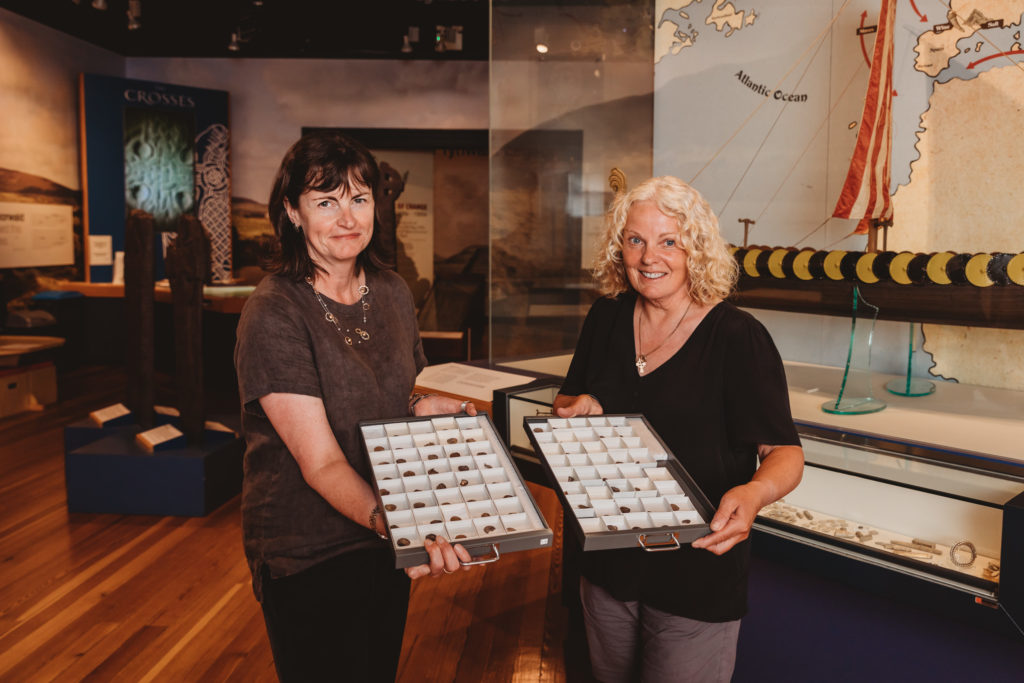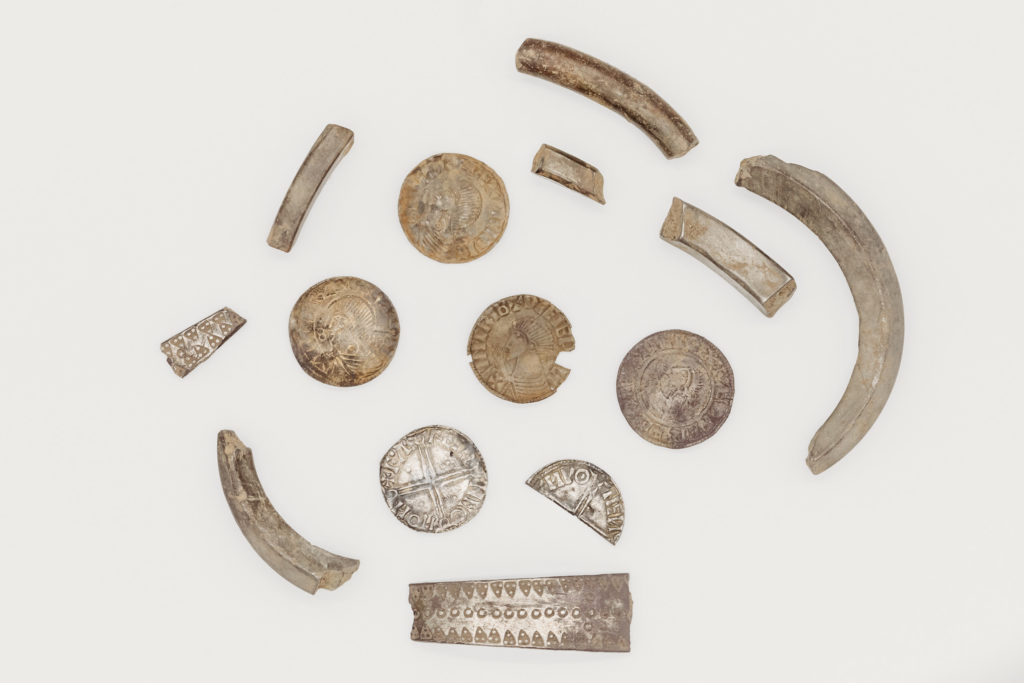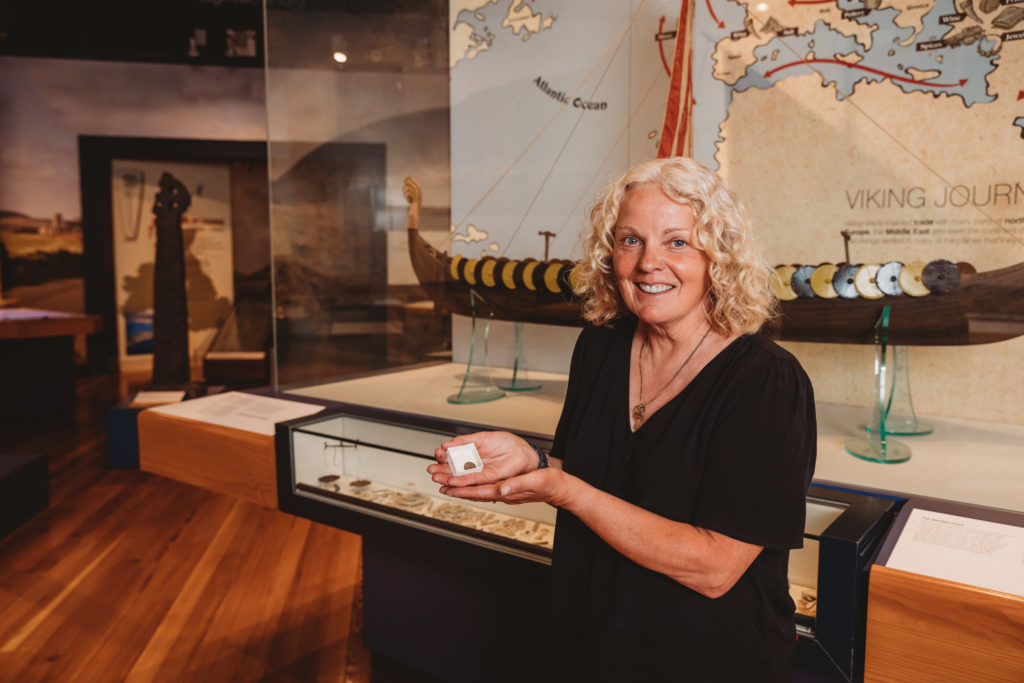2. Viking Treasure from the Northern Hoard discovered by Kath Giles
3. Allison Fox, MNH Curator for Archaeology and Kath Giles, pictured with the Northern Hoard
In December 2020, metal detectorist Kath Giles found a spectacular hoard of Viking Age treasure on the Isle of Man. In April 2021, Kath did it again! Dating to around AD 1030, this latest find has silver coins and pieces of cut silver armbands. The coins are pennies and were minted in England, Dublin, modern day Germany and the Isle of Man, demonstrating some of the extent of Viking trade and influence. Representations of Kings Sihtric Silkbeard and Cnut can be seen. The cut silver would have been used to pay for goods and there is a lead weight which may also have been used in trading. The earliest coins date from the late 900s and so this stash of wealth may have been built up over a few years – a kind of Viking piggy bank!
Our media release in relation to this spectacular find in detailed below, along with associated images and film content. High resolution images and raw footage is available by request. Media interviews are scheduled for tomorrow (Thursday), with additional time slots available tomorrow afternoon.
The Isle of Man’s rich Viking legacy has been further enhanced by the discovery of the Island’s latest treasure hoard, which was today declared Treasure by the Isle of Man Coroner of Inquests, Mrs Jayne Hughes.
The latest hoard consists of 87 silver coins, 13 pieces of cut, silver arm-rings or “hack silver” and associated artefacts. It was discovered in April by metal detectorist Kath Giles whilst metal detecting on private land.
The discovery marks the third major treasure inquest on the island in less than six months and is Kath’s fourth significant discovery since taking up metal detecting only three years ago.
The coins are generally silver pennies, mostly minted in England, Dublin, Germany and the Isle of Man. They are all around 2cm in diameter and around 1 gram in weight. Most of the coins date from around the AD 990s through to the 1030s.
Allison Fox, Curator for Archaeology at Manx National Heritage said:
“This is a wonderful find which helps further our understanding of the surprisingly complex Viking Age economy in the Isle of Man and around the Irish Sea area.
Dr Kristin Bornholdt-Collins, an independent researcher and numismatist based in New Hampshire, USA, has confirmed that the hoard includes pennies minted in Dublin, England, modern day Germany and the Isle of Man itself. Like our modern day coins, many have an image of the monarch. On the Irish and Manx coins, the profile of King Sihtric Silkbeard who served as Norse King of Dublin around 989 to 1036 AD can be seen, appearing to be giving a wave from a thousand years ago! King Cnut, King Aethelred II of England and also a Holy Roman Emperor, Otto of Saxony can also be seen.
Some of the coins have a design called a “long cross” on the other side. These lines were used to cut the coins when literally only a half-penny was needed.
The cut, or hack-silver pieces found with the coins are part of a flexible system of payment, where the value depended on the weight and purity of silver. It is expected that the coins and the hack-silver have over 90% silver content”.
The Isle of Man has a rich and tangible Viking legacy. There have been discoveries of other mixed hoards of Viking Age silver coins and hack silver from the Island. All of these have been the result of deliberate deposition and many with the intention by the original owner to reclaim the hoard material at a later stage. Very few items of hoard material have been found associated with graves and this is the case for this latest discovery.
Dr Bornholdt Collins said:
“The Northern Mixed hoard is the fourth Viking-Age coin hoard to be found in the Isle of Man in the last fifty years. It may have been added to over time, like a piggybank, accounting for some of the older coins, though for the most part it is a direct reflection of what was circulating in and around Man in the late 1020s/c. 1030.
Like the similarly dated, but much larger, Glenfaba deposit, found in 2003, the new hoard might be compared to a wallet containing all kinds of credit cards, notes and coins, perhaps of different nationalities, such as when you prepare to travel overseas, and shows the variety of currencies available to an Irish Sea trader or inhabitant of Man in this period. The two hoards together provide a rare chance to study the contents side by side, right down to the detail of the dies used to strike the coins. Having this much closely dated comparative material from separate finds is highly unusual and essentially “doubles” the value of each find.
In addition to the array of coins, both hoards contain a significant hack-silver or bullion portion, which would have been weighed out and possibly tested for its quality in the course of transactions. This is generally expected in finds dating to the ninth- and tenth centuries from viking regions, but appears to be a special feature of the later Manx hoards, too. This may be because bullion was especially convenient for international trade since it was practical for any size transaction and was decentralized, a currency without borders or political affiliation; in this sense, it was a modern-day equivalent to a cryptocurrency—we might even say it was something like the original ‘Bit-coin’! It seems only logical, then, that it was so popular in a cosmopolitan trading hub like Man, even several decades into the 11thcentury, when closely regulated minted silver was well on its way to becoming the norm across Northern Europe”.
The date of deposition of the latest hoard can be dated fairly closely due to the coin content to around AD 1035. This is the later era of Viking Age precious metal hoard deposition, as the practice only really lasted for a further forty years or so, with the earliest hoards dating to the AD 950s.
The find represents a medium-sized, discrete hoard of personal wealth, which was probably built up over a period of a few years, perhaps representing a short-term savings account.
The hoard will go on display in the new Viking Gallery at the Manx Museum from Thursday 14 July, prior to travelling off island for review by the Treasure Valuation Committee, an independent Committee which meets at the British Museum, providing advice on antiquities.
ENDS
Associated video content: https://www.youtube.com/watch?v=UxN-GSjcBjY&list=PLxvEbuf5XvSsawES9FQzvjk_ylegH2c8M.
Raw footage and additional interview content featuring Dr Kristin Bornholdt Collins available by request.
Notes for Editors:
A Note on Significance of the Objects
Many of the coins are of a type known as “Hiberno-Manx”. These are the earliest (so far) recorded coins that were minted in the Isle of Man. It is generally accepted that these coins were made using one coin die (or a set) that had originated in Dublin, but had been brought to the Isle of Man sometime around AD 1025. The die(s) degraded over time and by around AD 1065, production of the Manx coinage had ceased.
The inclusion of coins from England, Germany, and Dublin illustrate the trade networks that were present during this time. Although the coins represent different nations and rulers, they were transferable across country borders, due to their value being in their weight in silver – for example, a silver coin from Dublin could be used in England and vice versa.
The hack silver arm-ring fragments illustrate a similarly universal currency. In their complete form and worn as jewellery, the arm-rings would have been a very obvious show of wealth of the original owner. However, none of the arm-rings in this hoard are whole, all have been cut in antiquity.
This suggests that that they were the remains of what was left after various financial transactions and suggests that they are the result of accumulated wealth.
This typically Viking Age assemblage would have originally belonged a relatively high status individual. The full circumstances surrounding the deposition of the items in the ground will probably remain a mystery, but it was most likely either to have been a single event, possibly in haste in response to a threat, or possibly the equivalent of a short-term deposit account.
About Dr Kristin Bornholdt Collins
Kristin Bornholdt Collins, an independent researcher and numismatist based in New Hampshire, USA, studies the economy of the Isle of Man and the Irish Sea region during the Viking Age. She holds degrees in History and Archaeology from the University of St Andrews, Scotland and the University of Cambridge, and wrote her PhD dissertation on the Viking-Age coin finds from the Isle of Man (2003). Taking new finds into account, her continuing work focuses on the intersection of bullion, coin and other economies in the late Viking Age. She is also a specialist on the Hiberno-Manx coinage (c.1025–65). Kristin has authored and co-authored a number of articles, including the chapter on ‘Coinage’ in the New History of the Isle of Man (vol. 3, 2015), and is currently preparing the volume on the Manx Museum’s collection of early medieval coins (Anglo-Saxon, Hiberno-Scandinavian, Hiberno-Manx and other coins to c. 1275) to be published in the British Academy’s Sylloge of Coins of the British Isles (SCBI) series.
The Treasure Act 2017
The Treasure Act 2017 includes the following criteria for an object to be considered Treasure:
Part 1
Section 4 Meaning of “treasure”
(1) Treasure is —
(a) any object at least 300 years old when found which —
(i) is not a coin but has metallic content of which at least 10% by weight is precious metal;
(ii) is one of at least 2 coins in the same find of which at least 10% by weight is precious metal;
or
(iii) is one of at least 10 coins in the same find




